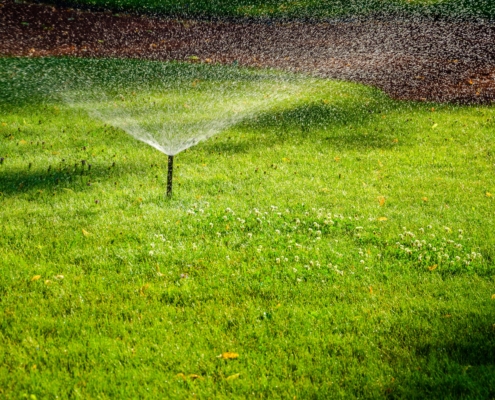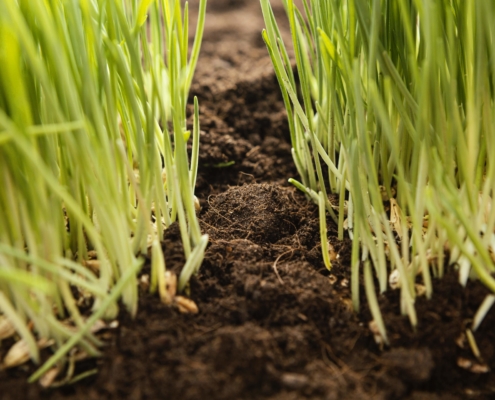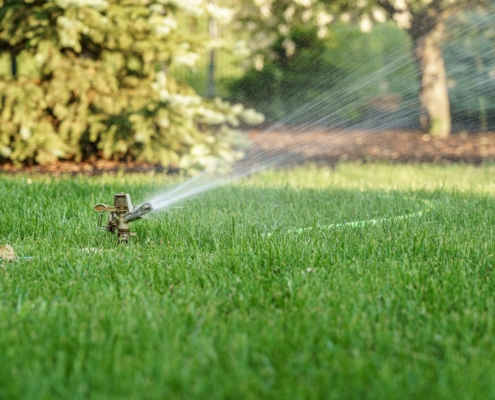How Long Does It Take For Grass Seed To Grow?
Planning to give your yard a beautiful lawn of fresh grass? Then you’ll need to know a thing or two beforehand. While grass is very willing to grow, it doesn’t thrive in all conditions, and in some cases may not grow at all.
Even under optimal conditions, grass seeds still need time to germinate and grow. You can expedite this process, but a little bit of patience is always required. Depending on the type of grass you’re growing, it may be anywhere between a week and a month before you begin to see growth.
If you’re in the planning stages of your grass-growth journey, then the information on this page will help things run as smoothly as possible. And if you’ve already planted your seeds, then we’ll answer a question that we’re commonly asked here at BBB Seed — how long does it take for grass seed to grow?
How Long Does Grass Seed Take To Grow?
5 Main Factors That Affect The Process
There’s no precise amount of time that grass seed needs to become a lawn of grass. Just because your neighbor’s grass took three months to grow, that doesn’t mean that you’ll also be waiting months — your lawn could be in pristine condition within six weeks if planted under optimal growing conditions.
Let’s take a look at the five factors that have the biggest impact.
1. Type of Grass Seed
Grass might all look the same to the untrained eye, but there are plenty of different grass species. At last count, there were more than 11,500 species of grass found in all corners of the planet. In the United States, you’ll find some 1, 400 species of grass.
You don’t need to know all of them or even a small fraction. Most grass species aren’t suitable for home use. Still, there are plenty to choose from on the market, and the one you select will play a big role in how long you wait for your lawn to grow.
Perennial ryegrass, for instance, typically has a germination time frame of around 5 – 10 days, which means you’ll begin to see shoots of growth within around a week. Others, such as Kentucky Bluegrass, can take between 14 – 30 days.
2. Germination
There are two parts to the grass growth process. The first is waiting for the seeds to germinate. After that, it’s waiting for the grass to grow to full coverage. The germination process is separate from the general grass growth rate but is arguably the most important. Once the grass has begun growing, it’ll typically continue to do so. If the germination process never takes place, then there’ll be no grass.
Grass germinates at different time frames depending on the species of grass, the climate, and the cultivation process. In general, you can expect grass seed to germinate in around 1 – 2 weeks, though it can take longer.
3. Weather
Grass is like most other plants: it does better in some weather conditions than others. For example, if it’s too cold or too hot, then the grass growth rate will be much slower, or may not happen at all.
It’s nearly always best to plant your grass seed in Spring or Fall, though choosing which one will depend on the type of grass you’re growing. There are cool-season and warm-season grasses; cool-temperature grasses do well in the slightly cooler temperatures of September and early October. Warm-temperature grasses do well in the warm days of Spring to early Summer.
Once the temperature dips below 50 degrees, the window for planting has been lost until the warm weather returns, since grass won’t germinate at that temperature. Similarly, while it’s ideal for there to be some rain during the germination process, if there’s too much — more than an inch in a 24-hour period — then the seeds will struggle. Finding the right balance between temperature and rainfall is the key to healthy grass growth.
4. Region
The United States is a big country, and as such, it features several different ‘growing regions’ that determine how long the grass-growing process will take. In all, there are nine lawn regions, with each having its own preferred grass species. If you live in Michigan, then you’d need to plant a species that does well in the northern climate, rather than one that’s suitable in Florida. Selecting the right grass for your region is key to enjoying a simplified growing process.
In general, the rule is as follows: if you live in a cold climate, then cold-season grasses are the way to go. In hot climates, warm-season grasses are best. Either type can be planted in the transitional zones that have both hot and cold temperatures, though extra care is required.
5. Soil Preparations and Conditions
Homeowners can help their grass thrive significantly by planting grass seed under optimal conditions, including by having the right soil conditions. Though it might all look the same, soil quality can vary widely — and if the conditions aren’t quite right, then the growth rate will be slow, or may not happen at all.
Soil should be free of debris (think: rocks, weeds, and roots), non-compact, and be the right temperature. Warm-grass species do well in soil with a temperature between 75 – 85 degrees; for cold-grass species, the optimal soil temperature lies between 60 – 75 degrees.
How Long Does it Take for Grass Seed to Sprout?
There’s a science behind growing grass, but it’s not precise. We’re still dealing with seeds, and they’ll sprout in their own time. So while you can create the ideal environment for grass to grow, how long it’ll take will depend on a number of factors, including the weather and type of grass being planted.
Some grass seeds sprout quicker than others. Ryegrass can show signs of growth within 5 – 10 days. Kentucky Bluegrass can take 2 – 3 weeks. You’ll need a little bit of patience as you wait for the grass seed to germinate, but unless you’ve made some errors in the planting process, then it will eventually start to grow.
How Fast Does Grass Grow?
We’ve outlined that the germination process will take around 1 – 3 weeks depending on the grass type. But that only reflects the beginning of growth. It’ll still take time before the grass grows to such a length that full coverage is achieved and you have the “lawn” look.
That process can take around 1 – 2 months. As with the germination process, how long it’ll take depends on the climate and species of grass. For grasses that are “easiest” to grow, such as Ryegrass, you can expect full coverage in around six weeks.
How to Speed Up Grass Seed Germination
Most commercially available grass species are pretty resilient and willing to grow, so even if the seeds aren’t planted in optimal conditions, they’ll still be likely to grow. It’ll just take longer.
If you’re looking to get a fresh lawn of grass as soon as possible, then there are several things you can do to speed up the grass seed germination process. One effective approach is to pre-germinate the grass seed. This isn’t essential if you’re planting in optimal conditions, but if it’s not quite perfect, then this can help speed things up. Doing this is a two-step process prior to sowing, which is as follows:
- Pre-soak the seeds in a tub of water for a day. After 24 hours, drain the water.
- Place the tub in a warm environment for a day or two. Once you see small shoots of growth, you can get the seeds in the ground.
How Often Should New Grass Seed be Watered?
New grass seed needs a lot of moisture for effective growth. If there’s a lot of rain forecast for your area, then you may need to manually water the seeds yourself. The seeds should receive some water every single day, especially if the area — and most importantly, the soil — isn’t usually damp. Water twice a day for the first few weeks, but be mindful not to overwater. The seeds must stay moist and never dry out.
How Can I Determine The Most Suitable Grass For My Local Area?
Choosing the right grass seed depends on the climate of your region and its unique requirements.
While many websites suggest options, they don’t always take local variations into account. With a wide range of grass types available, it’s important to remember that what works in one region may not be appropriate for another.
To ensure successful growth, it’s crucial to choose the right grass seed for your planting zone.
Here we provide you a list of specific grasses for each region of the United States, along with reliable recommendations and purchasing options. By selecting the appropriate grass for your area, you can enjoy lush and healthy lawns year-round.
Grass Seed for Direct Sun FAQs
Q: Will grass seed germinate on top of soil?
A: Grass seeds can germinate on top of soil, but it’s best if there’s a small covering of soil (no more than ¼ inch) on top.
Q: How quickly does grass seed dry out?
A: Good seed is dry to begin with and should be kept sealed from all moisture until planted.
Q: Can grass seed be pre-germinated?
A: Yes, you can pre-germinate grass seed by soaking the seeds in a water-filled tub for 24 hours. Then remove the water and place it in a warm environment for 1-2 days.
Q: Will grass seed grow if I just throw it down?
A: Grass seeds can grow if thrown on the ground, but they will likely grow more slowly — and birds may eat the seeds. A thin covering of soil is best. Nothing will grow without water.
Q: How long does it take for grass seed to germinate in October?
A: Cold-season grass seeds grow well in October. Warm-season grass seeds do not. Germination can take 1 – 3 weeks, depending on the type of grass.
Q: How long will it take for grass seed to grow 3 inches?
A: Grass grows 2 – 4 inches per month. For 3 inches, around 3 – 6 weeks is required.




